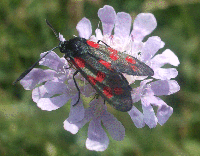When to Watch Wildlife | J | F | M | A | M | J | J | A | S | O | N | D | Search |
Current wildlife highlights | ||
| What's new on this site | ||
| Wildlife calendar | ||
|
Plants and Animals | ||
| Habitats | ||
| Wildlife sites | ||
| WWW links | ||
|
Guide Books | ||
| ||
© PMcS 2006 |
Habitats |
To help you find plants and animals you need to understand in what types of places they live and how they live together and interact. Each plant and animal ("species") favours a certain range of conditions (such as dragonflies like still fresh water). When groups of species like the same conditions it is possible to predict that they will be seen together. The types of places that they live are called "habitats". These are the main habitats that can be found in Britain (albeit somewhat simplified):
Plants and animals often interact within a habitat. One species may be the food of the other species, or may provide a home or nesting site for instance. Interactions can be very complex with some species are totally dependent on others for their own survival. The study of these diverse interactions and dependencies is called "ecology". Scientific classification of habitat types For scientific purposes habitats are now classified in Britain by the National Vegetation Classification scheme (NVC). The NVC uses the species and their abundance to establish distinctive types of each habitat. For instance there are a number of chalk grasslands (given the label 'CG') which can be told apart quite easily. The types of CG grassland are determined by their position, aspect and past and present management. The very richest type which is typical of sheep grazed chalk grassland in England is CG2. Within that there are even different CG2s!. For more information see the NVC site at the University of Lancashire. If you are really keen you can learn about this subject with the Fields Study Council. Although quite complex, the NVC is an extremely valuable tool for justifying a sites importance and communicating its character. In addition it does help to you to understand plant communities better and know what species you can expect to see. |
|
|
|
All images and text are copyright PMcS 2024
